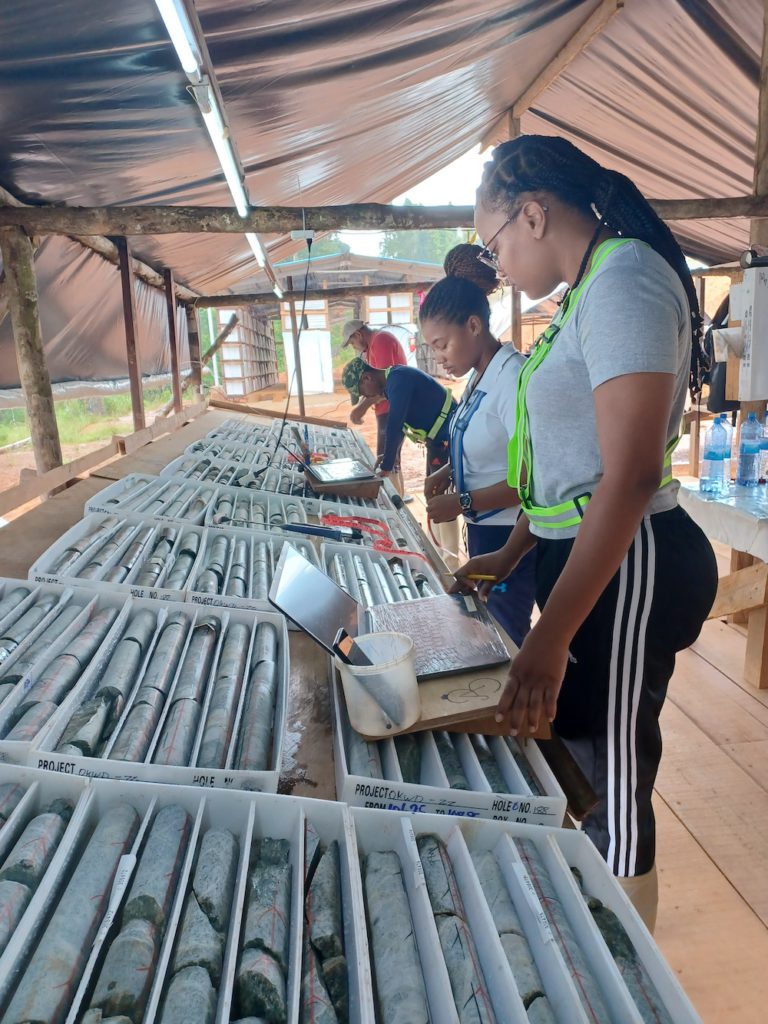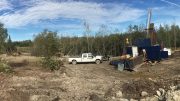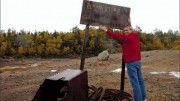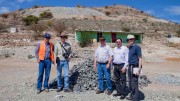On a 35-minute helicopter ride from Guyana’s capital of Georgetown to Reunion Gold’s (TSXV: RGD) Oko West project in the Cuyuni mining district, it’s easy to see where the South American country got its nickname — the land of many waters. We fly over the Demerara River and the mighty Essequibo River which leads down to Bartica — a town of 20,000 that’s also a gold mining gateway and lies at the confluence of three rivers — Essequibo, Mazaruni and Cuyuni.
The bird’s-eye view also makes it easy to see that Reunion is in the right place to look for gold. As we get closer to the project, 95 km southwest of Georgetown, past and current artisanal mining operations come into view through the dense forest canopy.
Reunion has a long history exploring the 400,000-sq.-km Guiana Shield in Guyana and neighbouring Suriname and French Guiana dating back to 2012. Its executive chairman David Fennell has an even longer history in the region going back to the early 1980s. Fennell, a mining veteran and founder of Golden Star Resources, which built and operated the Omai gold mine in Guyana with Cambior in the early 1990s, was also key in the discovery and development of the Gross Rosebel mine in Suriname (recently sold by Iamgold [TSX IMG; NYSE: IAG] to Zijin Mining).
Optioned in 2018, the Oko West claims are newer to Reunion’s portfolio. But it didn’t take long before it made a promising discovery that it’s now quickly advancing towards a first resource.
Despite the artisanal workings in the area, the company’s big find at Oko West — the Kairuni zone — was not discovered by small scale miners (although there is evidence of them throughout the concession), but through geochemical testing.
Soil sampling in early 2020 at the project, which is on strike with and adjacent to G2 Goldfields’ (TSXV: GTWO) separate Oko project to the north, outlined a 6-km gold-in-soil anomaly while following up on a 2019 airborne magnetic geophysical survey. The discovery was confirmed by trenching in late 2020 that returned highlights of 69 metres of 5.98 grams gold per tonne and 34.5 metres of 5.5 grams gold.
The very first drill hole at the project, part of a preliminary, 1,000-metre drill program in early 2021, cut 9.1 metres of 1.74 grams gold per tonne from surface, followed by 20.1 metres of 1.54 grams gold from 50 metres downhole.
Now, the company’s completed 62,000 metres of drilling (diamond and reverse-circulation), with plans to release an initial resource for the project in 2023. Drilling has so far outlined the Kairuni zone – the northern 2.5 km of strike of a 6-km shear zone — across up to 100 metres in width and 600 metres depth. Drilling has returned such positive results, Reunion announced in September that it would delay the initial resource from the third quarter as originally planned, since it would be “premature.”
At press time on Nov. 21, Reunion revealed that a new, high-profile president and CEO will take over from interim CEO Carlos Bertoni, who is retiring. Rick Howes, former CEO of Dundee Precious Metals (TSX: DPM), will join the company as of Jan. 1. Howes is a mining engineer with nearly 40 years of experience and a track record of overseeing on-schedule and on-budget capital projects and leading mining innovation.
‘Rapidly evolving’
During the site visit in early November, Reunion Gold’s vice-president of exploration, Justin van der Toorn noted that the project has evolved at rapid pace since the start of the first major drill campaign in June 2021. The camp, which has grown from about 20 people in early 2020 to regularly accommodating up to 90, reflects the ramp-up in activity. At the time of the visit, the company was in the midst of commissioning a new fuel storage facility, building a new workshop, and planning to expand capacity further to 120 people next year.
“It’s a very rapidly evolving camp, and it’s been quite an exciting period to see the project go from those initial couple of holes to what we now have and the potential that we have here,” van der Toorn said.
Reunion had three core rigs turning at the time, with another two just-arrived rigs about to be put to work. Van der Toorn said the five diamond drill rigs will give the exploration team capacity of about 7,000 metres per month. Having raised $36.8 million in June and $11.5 million in February, the company has around $50 million in its treasury — enough to fund work at that pace through the end of next year.
The company also recently converted its option agreement with a local permit holder to a prospecting licence, which is the first step to tenure for a foreign company. (Now that Reunion has the permit, the last remaining small-scale miner on the concession was just packing up to leave in November.)
Major drill program
The first major drill program at Oko West began in June 2021, with early results that included 43.5 metres of 2.92 grams gold per tonne starting from surface (hole 13) and 61 metres of 2.54 grams gold from surface (hole 14).
“We started out looking at more of a shallow system, trying to develop the potential here within the saprolite,” van der Toorn said.
The saprolite layer extends to about 80 to 100 metres, and was untouched by artisanal miners — locally known as pork-knockers.
“We’ve got the entire saprolite profile preserved, which is obviously the easy win as a starter pit on these kinds of projects,” van der Toorn noted.
More recent results reported in September included 52.5 metres of 5.19 grams gold from 4.5 metres depth in hole 135 and 49.8 metres of 4.12 grams gold from 221.7 metres in hole 124.
Though the strongest results have come from the Block 4 area of the Kairuni zone, Reunion has also hit nice grades and widths outside that block, including 37 metres of 2.99 grams gold in RC hole 205 in Block 6 to the south, and 67.6 metres of 1.21 grams gold in diamond drill hole 166B in Block 1 to the north.

In the core shack at Reunion Gold’s Oko West project in Guyana. Credit: Alisha Hiyate
‘More work to do’
Mineralization at Oko West is hosted in a combination of volcanics and sediments in a north-south shear zone, along at a volcano/sedimentary-granitoid contact. The bulk of the mineralization in the orogenic gold system is in sedimentary rock rather than granitoids, and shows excellent continuity from top to bottom.
“We do see a strong association with quartz veining,” van der Toorn said. “That said, the majority of our mineralization (is in) breccias, there’s sheared sediments with fractures well developed across them, and then foliation parallel quartz veins that also host gold,” he said, adding that the system is complex.
“It’s not like one vein that’s sometimes quite typical in orogenic gold systems, but it’s really a well-developed deformation zone within which you’re then precipitating gold through various mechanisms.”
The 2.5-km-long Kairuni zone has seen the bulk of drilling, with a 6,000-metre reverse-circulation drill program under way at the 3.5-km-long southern half of the system, dubbed the Takutu zone. There’s also further potential on the 44-sq.-km property in the Carol zone, a potential zone parallel to Kairuni , and the Bryan zone further west, which the company believes could be the hard rock source of downstream alluvial workings.
“Block Four (part of the Kairuni zone) has really delivered the heart of the high-grade mineralization, the very thick grades that we’re seeing in that package of sediments,” van der Toorn said.
“We are still trying to understand more of the geology here. Obviously, the drilling has gone very well and what that leads to is that you generally don’t actually spend much time thinking about the details of why and how it fits together,” van der Toorn conceded. “There’s more work to be done here.”
Reunion is keen to delineate and grow the deposit, but also test its depth potential.
“We’re focusing on developing at an inferred drill spacing as we go deeper down at depth,” van der Toorn said.
A particular focus is filling in the space between current resource drilling and the company’s deepest hole (112), which extended mineralization to about 600 metres below surface.
Reported in June, hole 112 cut 71.2 metres of 3.68 grams gold per tonne ending at a vertical depth of 575 metres. It was a 226-metre step-out from the previous deepest hole, 63, which cut 67.3 metres of 1.5 grams gold to a vertical depth of 349 metres.
As it grows Oko West, Reunion is also busy with environmental baseline work, a geotechnical study for the potential open pit, and a comprehensive bottle-roll test that will inform a large-scale metallurgical program to follow. (Preliminary bottle-roll tests indicated gold recoveries of 78-96%.)
‘Exciting’ discovery
The company’s discovery has not gone unnoticed. In September, BMO Capital Markets mining analyst Brian Quast initiated coverage of Reunion, calling Oko West “one of the most exciting discoveries in recent years.”
Quast, who believes the Kairuni zone’s near-surface high grades and “excellent widths” could make Reunion a takeover target, sees potential for a 2.2-million oz. resource in 38 million tonnes grading 1.8 grams gold per tonne when the company posts its first resource. Ultimately, the project could evolve into a series of open pits with longer-term underground production as well.
The analyst also points out that outside of power, infrastructure at Oko West is quite good. The road-accessible project is an eight-hour drive from Georgetown or a four-hour journey by a combination of road and boat. (There’s also potential for hydro power within 100 km of Oko West from the proposed 165-megawatt Amaila Falls project, or within 30 km of the site with modular, run-of-river hydro.)
And as luck would have it, Aris Mining (TSX: ARIS) has been upgrading the local Puruni Road that runs past Oko West for all-season access to its development-stage Toroparu copper-gold project to the west.
“In the past all these roads in the interior were a bit problematic but this is now a good all-weather road,” van der Toorn said.
With 990.5 million shares outstanding, Reunion Gold has a market cap of $438 million. At press time, it traded at 40¢ in a 52-week range of 11¢ and 48¢.





Be the first to comment on "Site visit: Reunion Gold speeds up drilling at Oko West in Guyana en route to 2023 resource "